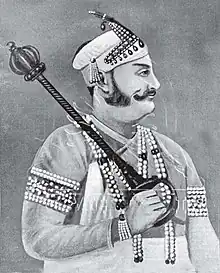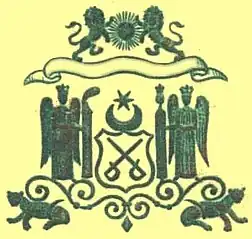Shams ul-Umara, Shams ul-Mulk, Shams ud-Daula, Nawab Muhammad' Abu’l Fath Khan Bahadur, Taigh Jang Bahadur ['Abu’l Khair Khan II] [Imam JungIII] was an Indian nobleman and founder of the House of Paigah.
‘Abu’l Fath Khan Bahadur, Taigh Jang bahadur | |
|---|---|
 | |
| Resting place | Paigah Tombs |
| Title | Shams ul-Umara
Shams ul-Mulk Shams ud-Daula Abu’l Khair Khan II |
| Successor | Nawab ‘Abu’l Fakhr |
| Parent |
|
| Family | House of Paigah |
Ancestry
Abu'l Fateh Khan was the thirteenth direct descendant of Shaikh Fariduddin Ganjshakar, a Punjabi Muslim Sufi of the Chishti order born near Multan (now in Punjab, Pakistan), whose lineage is traced to Omar bin Al-Khattab, the second Caliph of Islam.[1]
Abu'l Fateh Khan was born to Nawab Muhammad Abu’l Khair Khan, Shamsher Bahadur, Imam Jang I, the Governor of Shikohabad under Mughal Emperor Aurangzeb. Muhammad Abu’l Khair Khan was granted the hereditary title of Khan and rose to the command of an Imperial mansab of 2,500 zat under Emperor Aurangzeb; his statesmanship was noticed by Nizam-ul-Mulk (the then Prime Minister of Mughal, and later founder of Asaf Jahi dynasty and known as Nizam I) and was appointed as Deputy Governor of Malwa and Khandesh.
He joined Nizam on his way to Deccan and accompanied him in the battles against Maratha. During Nizam I's campaign to Delhi to negotiate and stop Nadir Shah, Khan safeguarded his Nizamat in Deccan and defeated a rebellion by his son Salabat Jung. During his career under Nizam I, he was appointed Qila Dar of Dhar (1724), Faujdar of Nabinagar, Mandu (1724), and later elevated to Naib Subadar-Deputy Governor Khandesh and Aurangabad. He was buried in Burhanpur. His titles are Khan Bahadur, Shamsher Bahadur, and Imam Jang I. He had two sons, 1st Abul Barakat Khan Imam Jung II, who was shot to death during his father's lifetime while inspecting the fort near Poona, which was captured from Maratha Empire. He is buried in Burhanpur.
Life and career
Abu'l Fateh Khan commanded several battles. He commanded The Battle of Udgir 1760 AD against Balaji Baji Rao Peshwa III, accompanied Nizam Ali Khan Asaf Jah II in all his campaigns, commanded Campaign Adoni against Tipu Sultan 1200 H (1781 AD), and he commanded the Battle of Nirmal 1783 AD against Ehtasham Jung (Zafar ud Dowla Dhaunsa). Abul Fatah Khan died at Pongel while on his way to face Tipu Sultan during the 2nd Mysore War on 1 January 1791. He is buried in the Paigah Tombs.
Personal life
Abu’l Fateh Khan married Ladli Begum Sahiba, the second daughter of his cousin, Muhammad Amjad Khan Bahadur. They had a son named Amir e Kabir Shams-ul-Umra I.
.jpg.webp)

Legacy
After the death of Abu'l Fateh Khan, his son inherited his titles and estate and married Sahibzadi Bashir unnisa Begum Sahiba, the youngest daughter of Asaf Jah II, Nizam ul-Mulk, Nizam ud-Daula, Nawab Mir Nizam Ali Khan. This began the tradition of the Nizam's daughters marrying noble young men from Paigah. These men also served as Amirs, holding honorary monarchal (standard) behind the Nizam.[2]
Nawab Abu'l Fateh Khan's descendants include Asman Jah, his great-grandson, who served as Prime Minister of Hyderabad and Amir.[3][4] He built the Mahboob Chowk Clock Tower,[5] Falaknuma Palace,[6][7] and the Spanish Mosque.[8][9][10]
See also
References
- ↑ bhopal14.
- ↑ Faruqui, Munis D. (2009). "At Empire's End: The Nizam, Hyderabad and Eighteenth-Century India". Modern Asian Studies. 43 (1): 5–43. doi:10.1017/S0026749X07003290. ISSN 0026-749X. JSTOR 20488070. S2CID 146592706.
- ↑ Lynton, Harriet Ronken; Rajan, Mohini (1974). The Days of the Beloved. University of California Press. ISBN 978-0-520-02442-7.
- ↑ Lethbridge 2005, p. 31.
- ↑ "After decades of neglect, Hyd's 126-year-old Mahboob Chowk clock starts ticking again". The News Minute. 1 October 2018.
- ↑ "Mirror to the sky: All about the Falaknuma Palace, playing regal host to Ivanka Trump". The News Minute. 2017-11-28. Retrieved 2023-04-11.
- ↑ "All About Hyderabad's Falaknuma Palace Where PM Modi, Ivanka Trump Will Dine". NDTV.com. Retrieved 2023-04-11.
- ↑ "On Independence Day, Spanish mosque in Hyderabad will open to all faiths". The Times of India. 2018-08-11. ISSN 0971-8257. Retrieved 2023-04-11.
- ↑ "The Spanish mosque: Moorish architecture in the heart of Hyderabad". The News Minute. 2016-09-24. Retrieved 2023-04-11.
- ↑ Bhavani, Divya Kala (2018-08-16). "Hyderabad's Spanish mosque: A serene place of worship and acceptance". The Hindu. ISSN 0971-751X. Retrieved 2023-04-11.
Sources
- "Paigah Tombs | Hyderabad District, Government of Telangana | India". Retrieved 2023-04-09.
- "Journal: Humanities. Section A., Volumes 33-36". University of Madras. 1961. p. 141.
- History of modern Deccan, 1720/1724-1948: Volume 1
- The Marathas 1600–1818, Band 2 by Stewart Gordon p. 169
- Hasan, Mohibbul (1971). History of Tipu Sultan (2nd ed.). Calcutta: THE WORLD PRESS PRIVATE LTD. p. 291.